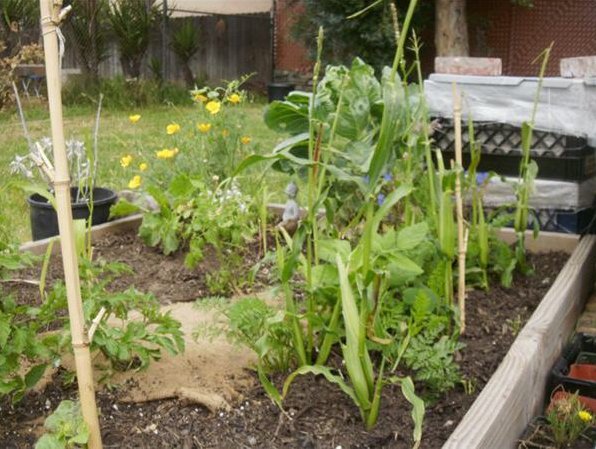
Plants don't care about fancy. They just need a little bit of soil for nutrients, and a whole lot of water and light.
You can use all sorts of containers to hold enough dirt and nutrients to grow a plant. If you have poor soil or no soil, only pavement, growing your plants in pots or raised beds helps concentrate the water and nutrients where the plant needs it and helps keeps plants out of harm's way.
You can create your own dirt by gathering and composting organic waste, like a little left-over food and lots of dried leaves and debris that fall from plants, or old dug-up plants that were cleared from some other part of your garden. Be careful not to use soil that may be contaminated with chemicals, like gravel from your drive way, and if you have organic matter that may have seeds in it, you should either burn it first, or water the pile and let the seeds start sprouting so that they're easier to kill by drying before you compost it.
Keep your compost outside and keep it moist, but not too wet or it will get swampy and smelly. A little bacteria, mold and some worms will help break things down. Encourage worms to live in your compost by digging up worms and throwing them in there. Discourage flies and grubs, by keeping it lightly covered and removing any grubs you see (chickens love to help with this). Use a lot of dry stuff like grass clippings or fallen leaves to balance out the wet kitchen trimmings and keep it from getting swampy. You can even use newspaper to balance the wet stuff. Now just let the compost sit for a few months, mixing occasionally.
Our getto gardening team uses large flat tupperware type bins to grow worms for our garden and composting. The second worm bin is to keep a healthy supply of worms to replenish the ones that die in the compost when you're stirring it. Check out L.A. City's Guide to Composting for some tips.
If you're lucky enough to have some yard space, you should still be composting. Just dig you compostibles down into the soil. Dig a big hole in the garden and drop kitchen waste in there. As you fill the hole, dig another and cover the old one with dirt. Each time you grow a crop, when it's done you just chop it up and add it to the next crop's dirt, improving your soil over time.
Here's a video of Keyhole Gardens, which allow you to create a productive garden using very little water and other resources. The idea is to concentrate the nutrients and water and keep the plants away from pests. See bakerinstitute.org.
Start with Beans
Regardless of the container you use, or where you get your soil, legumes (peas and beans) are a good starter plant because they're easy to grow, they don't take much room or much soil, they're easy to cook, and they're high in protein, they keep well, and they help pull nitrogen from the air and attach it to the soil, enriching it nd preparing it for other more demanding crops.
Beans are a must in vegetarian and vegan diets, and there is a high correlation between bean consumption and life expectancy, so the more beans you eat, the longer you'll live.
Legumes include beans (red, pinto, navy, black, fava, great northern, mung, and soy), peas, pole beans (like wax beans and haricots), peanuts (where the beans grow under ground), lentils and a few other things like alfalfa.
Beans are easy to cook, and some can be eaten raw. Some beans take a long time to cook, but they store well. If you don't have a favorite, use what ever they're selling at your garden store or on line, or try any fresh or dry beans from the grocery store (canned or frozen are no good for growing). Look for beans you already like to eat, or just start with peas or pea pods, because they're easy.
Peas
Peas and pea pods need a little less sun than other beans, and they also tolerate acidic soil better, but they have a short growing season. Pea pods can be eaten in salads used in fried rice, soups, steamed or grilled. Peas are good in hundreds of recipes. My favorite is corn beef hash with peas, but also, beef stew, chicken soup, chicken pot pie, pea soup, and carrots with peas.
Pole vs Bush beans
Most beans will start producing delicate tendrils right away that reach out and grab on to anything nearby that they can u to hold themselves up. Give them a stick, a wire frame, a fence, or even another plant like a sun flower to cling to as they grow. Some beans are sturdy enough to sit up as bushes, but it's still good to try to stake or cage them. Giving your plants support helps keep the beans out of the mud and away from pests.
Some beans, like snow peas, green beans and wax beans are generally eaten whole, with the pod. Most, like red beans, pinto beans, azuki, and mung are usually eaten without the pod, often ground up or boiled in water for a long time. Azuki and mung are often soaked in sugar and water and used as a filling in Asian desserts.
The drier beans do better in the hot sun and drier weather than the softer pod type, but give them lots of water anyway. The more water they get the bigger and more productive they will be. Although many people point out the beans have lovely flowers and can be beautiful, with their delicate curling tendrils, be aware that after a few months they'll get old and dry looking, but will continue to produce for several weeks. Once they've given up, be sure to save some beans for next year, and to stir the old plants into the compost pot and take advantage for all that cheap nitrogen they collected.
Growing beans.
It's good to germinate beans indoors, if only because it's so amazing to watch them grow. They usually only take a few weeks and they get big fast. Basically just put some beans in a bowl of water, put it in the sun, and don't let it dry out. One of the advantages to sprouting your bean before you plant them is that they get a ad start in growing before being subjected to the perils of birds and drying sun. The disadvantage is they don't really like human interaction and must be treated gently.



